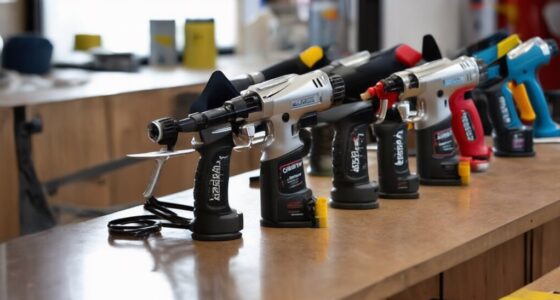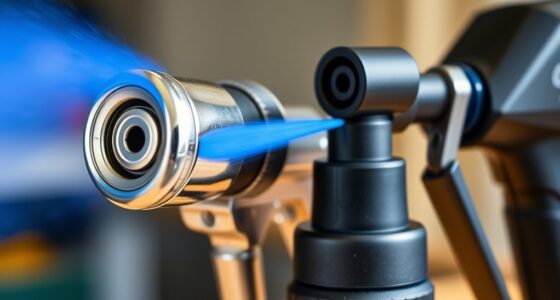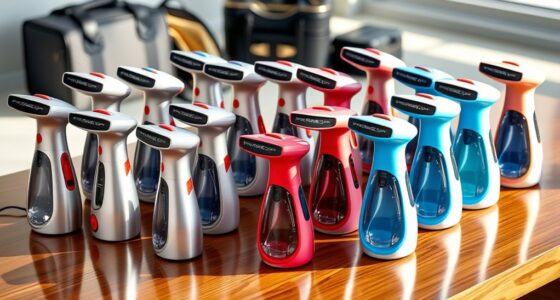Cordless paint sprayers give you great mobility and are perfect for small to medium projects or tight spaces, but their battery life limits continuous use and coverage. Corded models provide consistent power, making them ideal for larger jobs, but they restrict movement with cords. Your choice depends on your project size, portability needs, and budget. Exploring the details further will help you choose the best option for your home painting tasks.
Key Takeaways
- Cordless sprayers offer greater portability and ease of access, ideal for detailed work and tight spaces.
- Corded sprayers provide consistent power for large projects, ensuring uninterrupted, reliable performance.
- Battery life and recharge times in cordless models can limit work duration on extensive painting tasks.
- Cordless options are typically more expensive upfront, with additional costs for batteries and accessories.
- Performance stability in cordless sprayers depends on battery charge, affecting spray quality and finish consistency.
Portability and Ease of Use
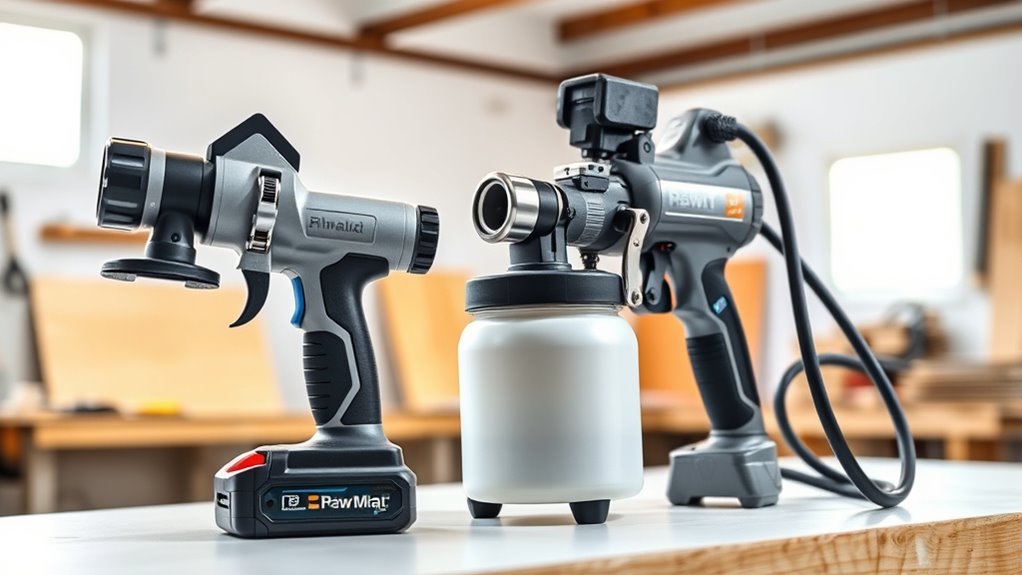
Have you ever tried moving a bulky, corded paint sprayer around your workspace? If so, you know it can be cumbersome, limiting your mobility and making the job less efficient. Cordless paint sprayers excel here, offering greater portability and ease of use. Without a cord tethering you to an outlet, you can easily reach tight corners and large surfaces without constant plug-ins. This freedom allows for better paint job accuracy, as you can maintain a steady hand and smooth motion. Plus, cordless models typically operate at lower noise levels, making the work less disruptive. Whether you’re working indoors or outdoors, the lightweight design and maneuverability of cordless sprayers help you complete projects faster and with more precision, all while keeping your workspace quieter and more comfortable. Additionally, battery life and power capacity are important factors to consider for uninterrupted work sessions, especially as advancements in battery technology continue to improve overall performance. Moreover, selecting a model with quick-charging capabilities can further enhance your efficiency during long or multiple-day projects. Being aware of noise levels can also help you choose a quieter model, which is beneficial in noise-sensitive environments. Furthermore, choosing a cordless model can reduce tripping hazards caused by cords, enhancing safety on your worksite.
Power Supply and Performance Stability
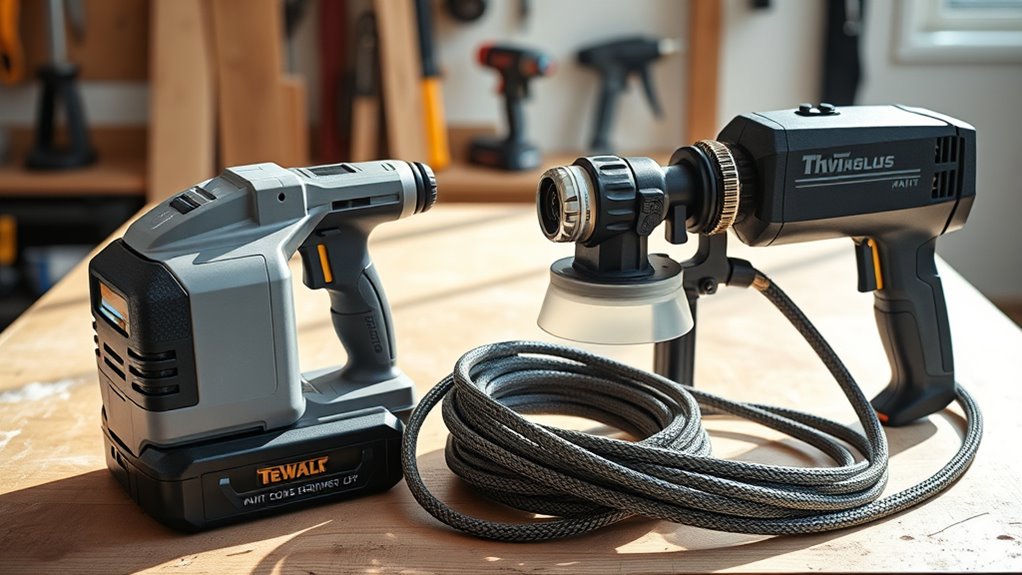
You need a paint sprayer that offers consistent power throughout your project, whether corded or cordless. Battery life and runtime can impact your workflow, especially on larger jobs. Understanding how each type maintains performance helps you choose the best option for your needs. Additionally, advancements in smart controls are enhancing the ability of cordless models to regulate power output more effectively during extended use. These innovations contribute to performance stability, ensuring reliable operation regardless of the duration of your tasks. Modern battery technology is also improving overall runtime and power consistency, making cordless sprayers increasingly comparable to their corded counterparts. Furthermore, ongoing AI-driven research is leading to smarter power management systems that optimize energy use and prolong device lifespan. This technological progress is helping to address AI security concerns by developing more robust and safer power regulation features.
Power Consistency During Use
While cordless paint sprayers offer the convenience of portability, their power consistency can fluctuate as the battery drains, potentially affecting performance. This inconsistency may lead to uneven paint application and variations in paint quality. Additionally, as the power dips, noise levels can change, sometimes increasing or causing irregular operation. Visualize the differences below:
| Battery Full | Mid-Use | Near Depletion |
|---|---|---|
| Steady power, smooth spray | Slight drop in stability | Inconsistent spray, increased noise |
| Ideal paint quality | Minor imperfections | Uneven finish, higher noise levels |
| Perfect paint application | Slight noise increase | Noticeable noise, possible spray fluctuation |
This table highlights how power fluctuations impact your work, emphasizing the importance of stable performance for best results. Moreover, understanding the power supply dynamics can help you better plan your projects. For example, battery capacity can determine how long you can work without interruption, making it a crucial factor in choosing the right sprayer. Additionally, awareness of performance stability is essential for achieving professional results with cordless models. Recognizing how power fluctuations occur can help you develop strategies to mitigate their effects during use. For instance, some cordless sprayers incorporate battery management systems to optimize performance and extend usage time.
Battery Life and Runtime
Battery life and runtime are critical factors that directly influence your painting session’s efficiency and quality. Your battery capacity determines how long you can work without recharging, so a higher capacity means longer periods of uninterrupted use. Keep in mind that charging time also impacts your workflow; faster charging allows you to get back to painting sooner. Some cordless sprayers offer quick-charging features, minimizing downtime, while others may require several hours to fully recharge. If you plan to tackle large projects, opt for a model with a larger battery capacity and shorter charging time. This ensures consistent performance and reduces interruptions, helping you to complete your work smoothly and efficiently. Balancing battery capacity with charging time is key to optimizing your cordless sprayer’s runtime.
Suitability for Different Project Sizes
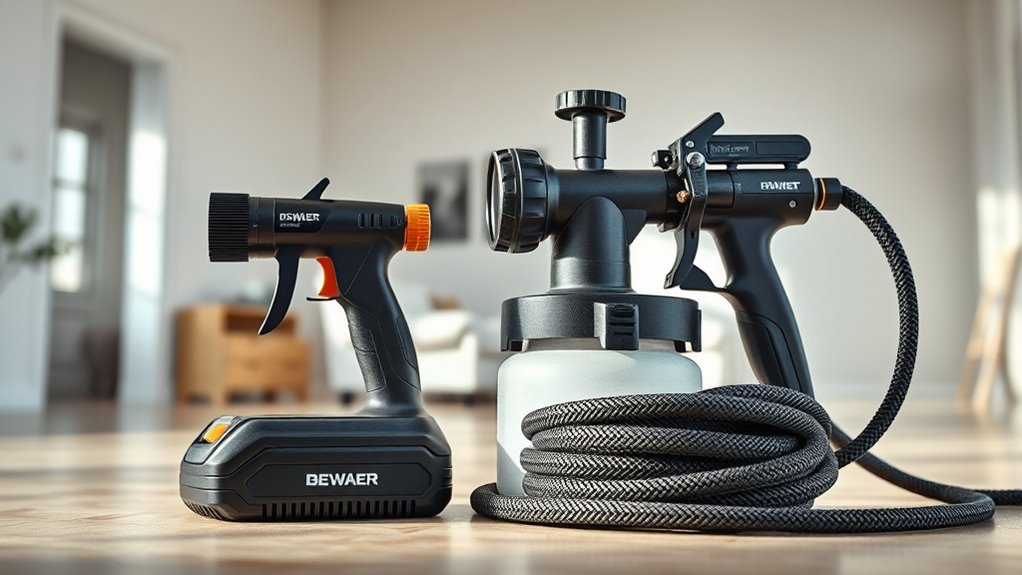
Your project size determines whether a cordless or corded sprayer works best. For small jobs, a cordless model offers quick setup and easy maneuverability, making it ideal for lightweight and portable designs. Larger projects require efficient coverage and reliable power, making corded sprayers a more practical choice. Additionally, self watering plant pots can be a helpful tool for maintaining healthy plants during projects. When considering storage and longevity, juice packaging and storage tips such as keeping the sprayer in a cool, dark place can help prolong its lifespan and ensure optimal performance. Proper maintenance, like cleaning the sprayer after each use, can also prevent residue buildup and preserve its nutritional value for future tasks. Incorporating financial management strategies like budgeting for equipment maintenance can further enhance long-term usage and cost-effectiveness.
Small-scale Projects Preference
For small-scale projects, cordless paint sprayers often provide the perfect balance of convenience and control. They excel when you need precision control for detailed work, allowing you to navigate tight spaces and intricate surfaces easily. Their portability means you won’t be tethered to outlets, making them ideal for touch-ups or craft projects. Additionally, many models are designed with features that accommodate cozy textiles like blankets and throws, ensuring smooth application even on textured surfaces. Since coastal environments are influenced by wave and wind action, using a cordless sprayer helps maintain control against air currents that could affect spray patterns. Moreover, their user-friendly setup allows for quick preparation, saving valuable time on small jobs. Understanding the safety and maintenance needs of cordless sprayers can further enhance their effectiveness for your projects.
Large-area Coverage Efficiency
While cordless paint sprayers excel at providing control for small, detailed projects, their limited battery life and reduced power can make large-area coverage more challenging. To maximize efficiency on bigger surfaces, you’ll need to consider the right paint sprayer accessories, like larger capacity paint cups or extensions, to reduce refilling interruptions. Proper paint mixing techniques also play a pivotal role in ensuring a smooth, consistent spray, preventing uneven coverage or clogs. Corded sprayers generally deliver more continuous power, making them better suited for extensive projects such as walls or fences. If you’re tackling large areas, investing in the right accessories and mastering paint mixing techniques can boost your coverage speed and quality, making your project smoother and more efficient.
Portability and Accessibility
Cordless paint sprayers offer unmatched portability, making them ideal for quick touch-ups, tight spaces, and projects where mobility is essential. With their battery compatibility, you can work without worrying about power outlets or long cords, giving you the freedom to move around effortlessly. This flexibility is perfect for small to medium projects or areas that are hard to reach. Plus, cord management is simplified, reducing tripping hazards and clutter. You won’t need to constantly plug and unplug, saving time and effort. However, keep in mind that battery life can limit continuous use, especially for larger projects. Still, for accessibility and ease of use in various project sizes, cordless sprayers deliver convenience that corded options can’t match.
Battery Life and Recharging Needs
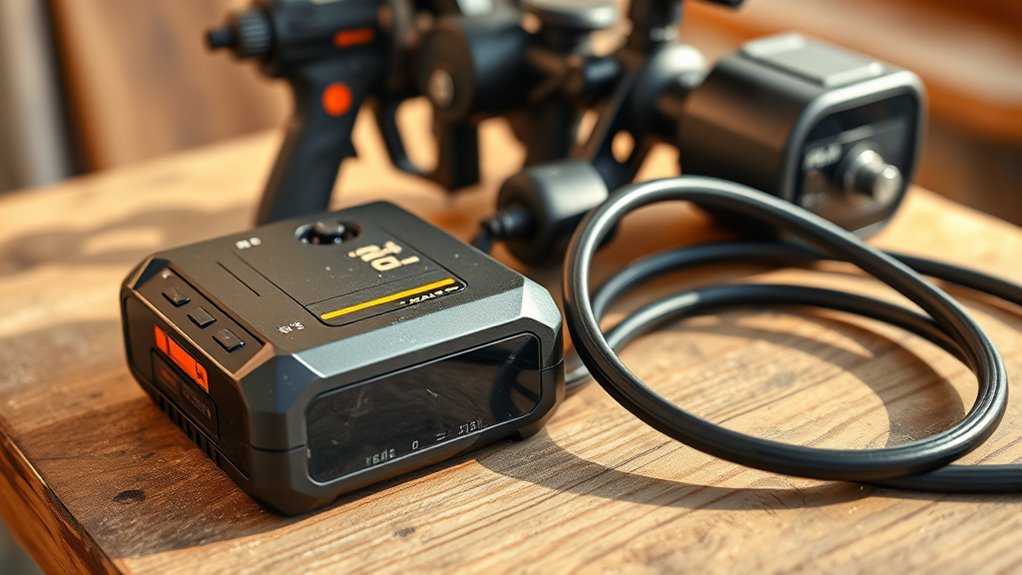
Battery life is a crucial factor to weigh when choosing a cordless paint sprayer, as it directly impacts how long you can work without interruption. Longer battery longevity means fewer breaks for recharging, allowing you to complete larger projects more efficiently. Most cordless sprayers have batteries that last between 20 to 60 minutes of continuous use, depending on the model and paint thickness. Recharging frequency varies accordingly; some batteries recharge in just 30 minutes, while others may take over an hour. Keep in mind that frequent recharging can slow down your workflow, especially if you’re working on a big area. To avoid disruptions, consider models with longer-lasting batteries or spare batteries to swap out as needed.
Cost and Maintenance Considerations
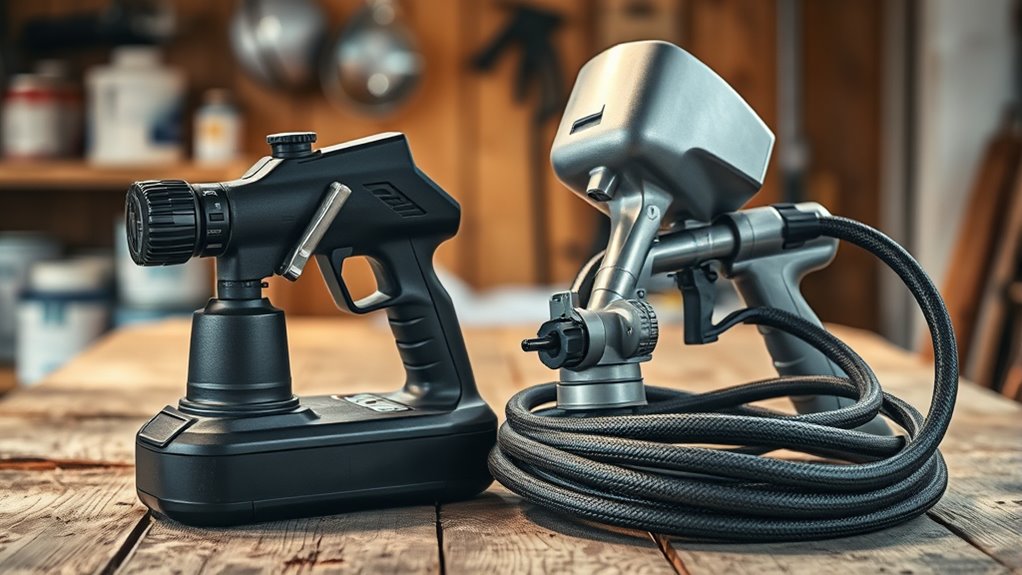
Cost and maintenance are important factors to contemplate when selecting a paint sprayer, as they can considerably affect your overall budget and ease of use. With cordless models, you might face higher initial costs but benefit from fewer cord-related issues. For corded sprayers, expect lower upfront expenses but potential long-term costs due to wear and tear. Consider these points:
- Replacement parts: Cordless units may require frequent battery replacements.
- Charging stations: Additional costs for charging accessories in cordless models.
- Long-term costs: Corded sprayers generally have lower maintenance expenses.
- Upkeep: Both types need regular cleaning to prevent clogs and ensure longevity.
Balancing initial investment with ongoing maintenance helps you choose a sprayer that fits your budget and minimizes future expenses.
Limitations and Potential Drawbacks
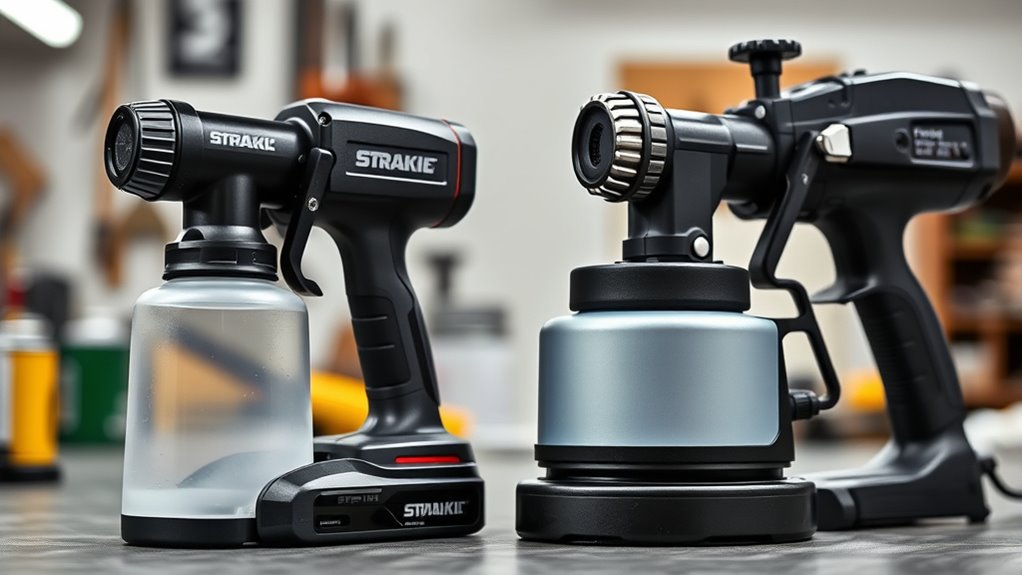
While cordless paint sprayers offer portability and convenience, they often come with limitations that can affect your project. Limited mobility and restricted reach mean you might struggle with large or complex areas. Battery life can also be a concern, forcing you to pause or switch batteries frequently. Additionally, these sprayers may produce less consistent results compared to corded models.
| Limitation | Impact | Solution |
|---|---|---|
| Restricted reach | Hard to cover large surfaces | Use extension wands or cords |
| Battery life | Interrupts workflow | Keep spare batteries ready |
| Limited mobility | Difficult in tight spaces | Opt for models with better design |
Frequently Asked Questions
Which Type Is Better for Detailed or Intricate Painting Tasks?
For detailed or intricate painting tasks, a corded paint sprayer often provides better precision detail and control. The continuous power supply lets you focus on achieving a smooth, even finish on intricate designs without worrying about battery life. You can work longer without interruptions, ensuring clean lines and fine details. While cordless sprayers offer convenience, corded models give you the steady power needed for complex, precise painting projects.
How Do Weather Conditions Affect Cordless and Corded Sprayers?
Weather conditions directly impact your cordless and corded sprayers. Cold or humid weather can reduce your battery life, causing your cordless sprayer to run out of power faster. Additionally, extreme temperatures and moisture can affect power consistency, making both types less reliable. Strong winds might spread paint unevenly, and rain can damage equipment. Always consider weather before painting outdoors to guarantee ideal performance, especially with cordless models that rely on battery efficiency.
Are There Any Safety Concerns Unique to Each Type?
You might worry about safety when using paint sprayers, but each type has unique concerns. For cordless sprayers, battery safety is key—avoid overcharging and handle batteries carefully to prevent electrical hazards. For corded sprayers, watch out for electrical hazards from the cord and outlet. Always follow safety instructions, wear protective gear, and inspect equipment regularly to minimize risks and keep your painting project safe.
Can Cordless Sprayers Handle High-Volume Commercial Projects?
Cordless sprayers can handle high-volume commercial projects, but you need to contemplate battery life and power consistency. They often have limited runtime, so frequent recharging can slow your work. While advancements improve their power, corded sprayers usually provide continuous, reliable power for large jobs. If you’re working on big projects, a corded sprayer might be more efficient, ensuring steady performance without interruptions.
What Are the Environmental Impacts of Using Each Type?
Environmental effects evoke concerns with electric equipment. Corded sprayers conserve electricity by plugging into power sources, reducing battery waste but increasing energy use. Cordless sprayers, however, consume electricity during charging, contributing to energy demands, and pose environmental risks through battery disposal. You should consider both options’ ecological impacts, weighing the convenience of cordless batteries against the environmental costs of electricity consumption and battery disposal.
Conclusion
Choosing between cordless and corded paint sprayers depends on your project needs. Think of it like a tool’s energy source: mobility offers freedom, but consistent power guarantees reliability. Sometimes, the best option isn’t the most convenient but the one that delivers steady results. Remember, the right sprayer isn’t just about convenience—it’s about understanding your project’s true requirements. Trust that evaluating your needs will lead you to the most effective choice, no matter the technology.
Franz came aboard the Paint Sprayer Zone team with a background in both journalism and home renovation. His articulate writing style, combined with a passion for DIY projects, makes him an invaluable asset. Franz has a knack for breaking down technical jargon into easy-to-understand content, ensuring that even the most novice of readers can grasp the complexities of paint sprayers.



